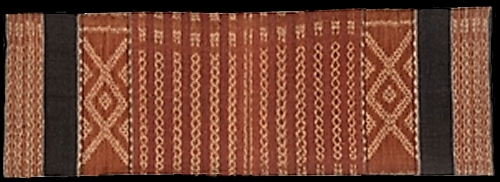Mysterious RaijuaTextiles from Raijua are rare to very rare. The Pusaka Collection holds about one sixth of all published pieces. Apart from rare, Raijua textiles are also mystifying: we know next to nothing about them. Only one researcher, Japanese professor Akiko Kaguiya has spent considerable time on the island, and a copy of her book is as hard to find as a Raijua textile.A few types of Raijua ikat, especially men's wraps, are so similar to their Savu counterparts that they are very hard to distinguish, other types are uniquely Raijuan. One of these is a long shawl for men, higi mea (see PC 170), executed in a dark red, like oxblood, with very fine weaving. As these were made and used for funeral purposes, few have come out onto the market and most went to the grave with the people they were made for. Only about a dozen have been published. Competition or care?One of the most remarkable Raijua ikat textiles is a very small ceremonial sarong, measuring about 40x90 cm. This is not children's wear, as one is allowed to wear ikat only after the onset of puberty. According to one respected informant these petite sarongs, of which only a few are known, are sacred textiles made specifically for the occasion of the birth of a child. These were never worn, but kept in the tegida, the communal hut of the wini, till the day a baby was born and then used to 'receive' it. Presumably they were also used for the Hapo Ana ritual, a ceremony similar to baptism in that it welcomes the child into the community.Some of these birth sarongs (see PC 105) use a type of weaving that is not found on Savu: the fine warp thread is a little overturned, resulting in a pleasant crêpe-like texture, ideal indeed for a baby's first contact with the material world. Another few of these Raijua birth sarongs (see PC 106) were dyed only with use of earth pigments, tanah lumpur. The significance of the avoidance of vegetable dyes is one of the mysteries surrounding Raijua and its textiles. 
One of the small Raijua textiles from the Rautenstrauch-Joest Museum. Its adat function was to serve as the first cloth in which to wrap a baby immediately after birth. Very similar to some of the smaller Raijua textiles in the Pusaka Collection. A rather sobering explanation for the existence of these small Raijua sarongs is told by Duggan in her Woven Stories: "In Raijua the wini (female clans) compete for holding the highest position, calculated on catagories and number of cloths owned. Small-size weaving are then produced which have the same value as a regular red sarong." As Duggan clearly is very well informed about cloths from the archipelago (though more about Savu than Raijua, from which it is rumoured she was long 'banished' by the Japanese researcher Kagiya, who told women of Raijua not to trust her) the explanation Duggan gives does not explain the rarity of the small sarongs, nor the crêpe-like weaving of above-mentioned piece, which does make sense in the context of baby care, but none in the context of competition, as the required lifting of the warp, thread by thread, is an immensely time consuming process, not favoring speed of production. For now perhaps it is best to assume that the diverging stories about the nature of these small sarongs are true in parallel. |


